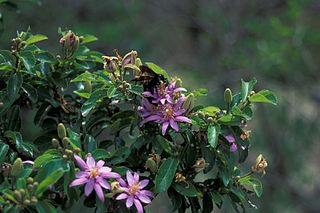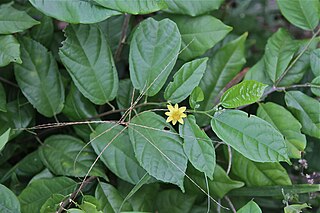
Malvaceae, or the mallows, is a family of flowering plants estimated to contain 244 genera with 4225 known species. Well-known members of economic importance include okra, cotton, cacao, roselle and durian. There are also some genera containing familiar ornamentals, such as Alcea (hollyhock), Malva (mallow), and Tilia. The genera with the largest numbers of species include Hibiscus, Pavonia, Sida, Ayenia, Dombeya, and Sterculia.

Bombacaceae were long recognised as a family of flowering plants or Angiospermae. The family name was based on the type genus Bombax. As is true for many botanical names, circumscription and status of the taxon has varied with taxonomic point of view, and currently the preference is to transfer most of the erstwhile family Bombacaceae to the subfamily Bombacoideae within the family Malvaceae in the order Malvales. The rest of the family were transferred to other taxa, notably the new family Durionaceae. Irrespective of current taxonomic status, many of the species originally included in the Bombacaceae are of considerable ecological, historical, horticultural, and economic importance, such as balsa, kapok, baobab and durian.

Malvoideae is a botanical name at the rank of subfamily, which includes in the minimum the genus Malva. It was first used by Burnett in 1835, but was not much used until recently, where, within the framework of the APG System, which unites the families Malvaceae, Bombacaceae, Sterculiaceae and Tiliaceae of the Cronquist system, the aggregate family Malvaceae is divided into 9 subfamilies, including Malvoideae. The Malvoideae of Kubitzki and Bayer includes 4 tribes:

Grewia is a large flowering plant genus in the mallow family Malvaceae, in the expanded sense as proposed by the Angiosperm Phylogeny Group. Formerly, Grewia was placed in either the family Tiliaceae or the Sparrmanniaceae. However, these were both not monophyletic with respect to other Malvales - as already indicated by the uncertainties surrounding placement of Grewia and similar genera - and have thus been merged into the Malvaceae. Together with the bulk of the former Sparrmanniaceae, Grewia is in the subfamily Grewioideae and therein the tribe Grewieae, of which it is the type genus.
João Geraldo Kuhlmann was a Brazilian botanist.
Colona poilanei is a species of flowering plant in the Malvaceae sensu lato. family. It is endemic to Vietnam, where it is described as a near-threatened small pioneer tree found in areas of lowland secondary, disturbed and recolonising tropical forest.

Glyphaea is a genus of African flowering plants in the family Malvaceae, subfamily Grewioideae; it was previously placed in the Tiliaceae or Sparrmanniaceae.
Grewia bilocularis is a species of flowering plant in the family Malvaceae sensu lato or Tiliaceae or Sparrmanniaceae. It is found only in Yemen.
Grewia goetzeana is a species of flowering plant in the family Malvaceae sensu lato or Tiliaceae or Sparrmanniaceae. It is found only in Tanzania.
Grewia limae is a species of flowering plant in the family Malvaceae sensu lato or Tiliaceae or Sparrmanniaceae. It is found only in Mozambique.

Grewia transzambesica is a species of flowering plant in the family Malvaceae sensu lato or Tiliaceae or Sparrmanniaceae. It is found only in Mozambique.
Microcos erythrocarpa is a species of flowering plant in the family Malvaceae sensu lato or Tiliaceae or Sparrmanniaceae. It is a tree endemic to Peninsular Malaysia. It is threatened by habitat loss.

Microcos is a genus of flowering plants in the family Malvaceae sensu lato or Tiliaceae or Sparrmanniaceae.
Microcos globulifera is a species of flowering plant in the family Malvaceae sensu lato or Tiliaceae or Sparrmanniaceae. It is a tree endemic to Peninsular Malaysia. It is threatened by habitat loss.
Microcos laurifolia is a species of flowering plant in the family Malvaceae sensu lato or Tiliaceae or Sparrmanniaceae. It is a tree endemic to Peninsular Malaysia. It is threatened by habitat loss.
Mollia glabrescens is a species of flowering plant in the family Malvaceae sensu lato or Tiliaceae or Sparrmanniaceae. It is found only in Guyana.

Helicteroideae is a subfamily of the family Malvaceae. Some taxonomists place genera in Helicteroideae in distinct families Durionaceae and Helicteraceae, while others recognizes the tribes Durioneae and Helictereae.

Malveae is a tribe of flowering plants in the mallow family Malvaceae, subfamily Malvoideae. The tribe circumscribes approximately 70 genera and 1040 species and has the greatest species diversity out the three tribes that make up Malvoideae. The flowers of Malveae are five-merous with a characteristic staminal column, a trait found throughout Malvoideae. Although there are not many economically important species within Malveae, the tribe includes Althaea officinalis, otherwise known as the marsh-mallow.
Trichospermum is a genus of flowering plants in the family Malvaceae sensu lato or Tiliaceae or Sparrmanniaceae. Species are distributed in Malesia to the tropical Americas.









